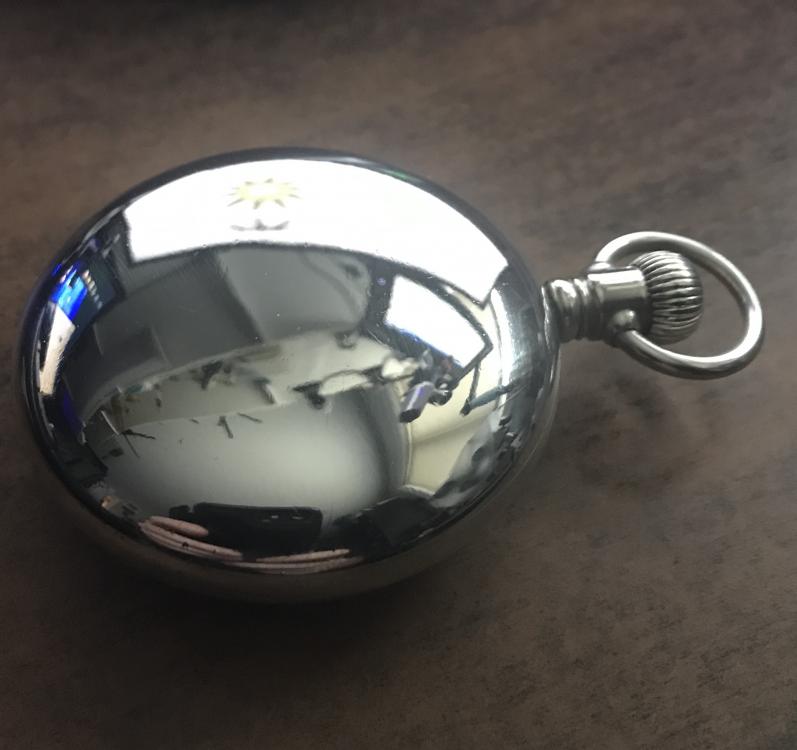Leaderboard
Popular Content
Showing content with the highest reputation on 04/04/21 in all areas
-
If you're burnishing a jewel in you should always modify the edge. Otherwise trying to burnish over a square energy is problematic even though we see people do it. There's a reason why the jewels had the shape they did you should modify the jewels to fit the setting rather than to force the setting to a modern jewel. If you're going to use a unmodified modern jewel just friction at him like you're supposed to. If you going to do the burnishing you cannot push the jewel out you will usually or as you discovered break the setting. A better way is to smash the jewel and then open up the setting. Or use the tools specifically designed to do this. Because as you've noticed the setting was holding nice and tight pushing the jewel out has a tendency to break the setting. If you have a modified jewel in other words the rounded edge you could always try because you don't have a lot of choices here so you might as well try the choices you have. But it looks problematic as to whether you have enough material. So you may be able to make a micro cut because you don't have a lot of room and have enough material to burnish. But only with a modified jewel because I doubt should have enough to go over a conventional jewel. The other option a course is because it looks like the setting is almost smooth inside would be to fit a modern jewel and not worry about the burnishing aspect. Providing there still am enough material left to hold.3 points
-
I designed and printed this. It has a bearing embedded in it with a small clearance to create a nice rotation feel. The PLA I used prints beautifully and allows you to sand it a little which creates a tactile smooth finish.2 points
-
Hi JD, You use them like any other countersink when you need a spherical countersink. Place over the hole and turn between your fingers. Re-bushing or re-jeweling is one example when you need to make a spherical countersink to hold the oil. Cheers and happy Easter from Hamburg Alex p.s. not meant that way but occasionally I use them free hand on the t-rest on the lathe to cut palm tree like grooves on a piece of 5mm brass rod to later serve as a handle for small tools. For Centre punches, hand levers and the like. Works like charm.2 points
-
1 point
-
Just as a reminder from reading your description a quick fix of changing a mainspring will not solve the problem of when was the last time this watch was serviced? In other words of it hasn't been serviced like forever a new mainspring is going to be problematic as to getting the watch to properly run. If you are doing a quick fix of changing the mainspring there should have been zero reason to loosen the bridge over the train wheels. As soon as you loosen the bridge the pivots come out of the jewels and disaster will happen if you're not really careful. The above quote is really interesting? You cannot move a wheel if it's pivot is still in the jewel the bridge has to be lifted up high enough to give you clearance. Normally you shouldn't have had two of remove the bridge over the wheels. As soon as you loosen the screws they give is the possibility of as the wheels to move around and come out of the jewels if you're lucky. If you're unlucky doing this you'll break a pivot. Attempting to put a bridge back on without proper site of the pivots in the holes etc. will probably break a pivot. Ideally you should remove the balance wheel and the pallet fork for proper clearance and to verify that there are indeed where there supposed to be. You also want to be really careful when you're tightening the screws up not the force anything otherwise conceivably you could knock the jewels out of place. I think rapidly of reached that point of time where a quick fix isn't what you should be doing you're going to have to do more disassembly because trying to do quick fixes without proper disassembly usually leads to disaster and very likely if you break the pivot a new escape wheel plus whatever else gets damaged in the process.1 point
-
1 point
-
1 point
-
1 point
-
1 point
-
Then just as a reminder swapping hairsprings can be a challenge because there vibrated to each balance wheel. In the first link you'll notice the reference to the balance jewel assembly? In other words non-shock protected and shock protected that means two separate balance wheels. Then normally get a picture of the front and the back of the movement any variations and you get more pictures like we have here? http://www.ranfft.de/cgi-bin/bidfun-db.cgi?10&ranfft&0&2uswk&AS_976 You probably don't want to look at the next link because? One of the problems with some vintage watches it may have gone through evolution of components. Especially if the Watch was made over a long period of time because it was popular or a popular size or some other factor where it evolved a lot. In this link we get a clue to the problem how many Balance completes for your movement? appears to be 11 different balance completes. Then things get more interesting balance staffs there appear to be 19 of those. You'll notice at the very top of the page is actually tell you which staff is the most popular so this tells the material houses aware of the fact that people might be having confusions but just because it's the most popular doesn't mean it's the one that you Have. Then it appears to be you have four different roller assemblies. I think it might help of you would give us complete picture of the movement front and back. http://cgi.julesborel.com/cgi-bin/matcgi2?ref=AS_9761 point
-
1 point
-
I have a clock hairspring that I accidentally "coned" when I forgot to unpin the hairspring before separating the plates. The concept is interesting but the jaws will have to be much finer for the hairspring I mangled. Maybe modifying a pair of cheap Indian made tweezers would work for me.1 point
-
I have a mangled hairspring project in my future...will consider this perhaps.1 point
-
1 point
-
1 point
-
1 point
-
When I was an apprentice fitter we used these products with amazing success. Ok, it was on industrial equipment, but maybe it has a place here as well? I wonder if one of these products would be able to be used?1 point
-
Here is the title to the original thread in which I purposely showed a SMALL ZIPLOC BAG. " Tips on removal , cleaning and reinstalation of fiddly cab jewels " The bag Idea occured to me over thirty years ago and has never failed. The story has undergone many changes eversince, cutest version was someone made a plastic tent to carry out the task under, run short on oxygen under the tent a got dizzy. ? Regs1 point
-
There was a video posted on the making an escape wheel , CORPELA (if I correctly spelled his name) and his skilled team had to make special bits. I,d say it is high skill machining. I don't believe acceptable result can be expected by hand filing or anything of the sort. Perhaps 3D printing. Regs1 point
-
The dental lab that I use uses 3D metal printing to construct their crowns. The process involves scanning the object and the printer uses a laser to fuse very fine metal powder into the object you wish to print. I was skeptical at first but all the crowns I've issued are still in the patients' mouths. The metal it prints out has no visible porosity unlike traditional casting methods. The metal is a non precious alloy, similar to stainless steel. I wonder if anyone has adapted this technology to print watch components.1 point
-
A lot to get through here. Early clocks such as Victorian and earlier would be down to cost. It's that simple. The clock was just an example of the sort of thing to start with. If you look it has an open mainspring so you don't need a mainspring winder. French clock movements are wonderful to work with. If you break a part it can be very hard to replace that part without some sort work needed. Because they are so good it is normally not just dirt that stops them, pivot wear, so you need a lathe. Re bushing which is not normally carried out by someone just starting you need certain tools for that work which I don't expect a beginner to have. You also need a mainspring winder again not a beginners tool. If you repair one of these french movements properly you have to polish every brass part, all the steel screws need to have there burr removed polished in a lathe and blued. I'm not trying to put you off but I believe in doing the job properly with no short cuts. If you decide to have a go I will help you.1 point







